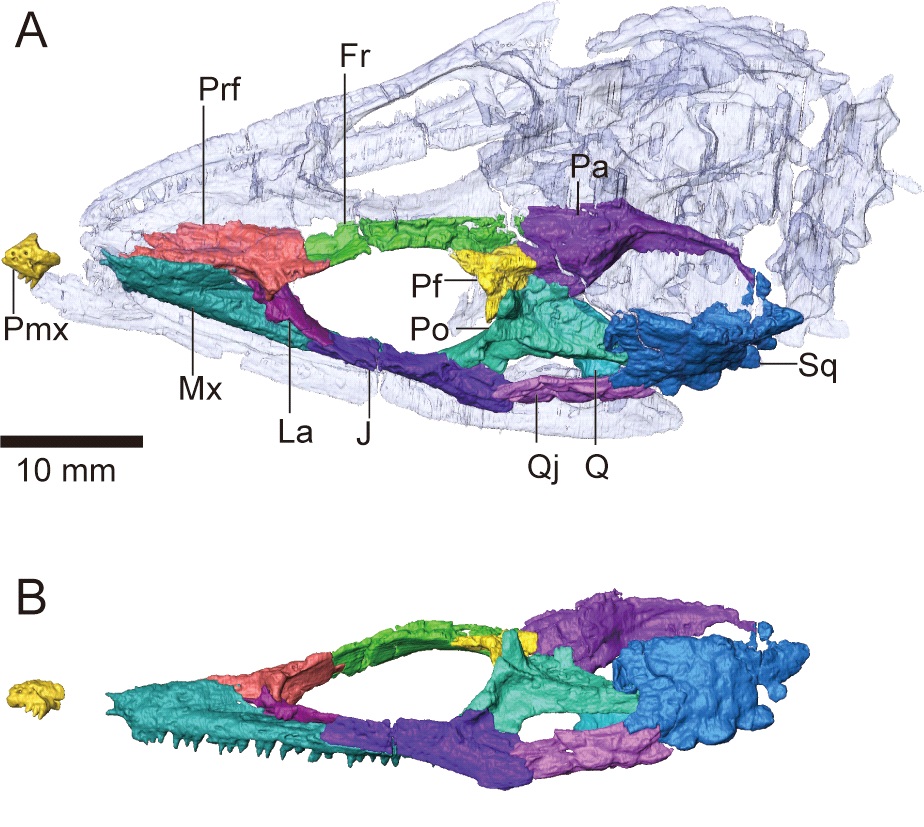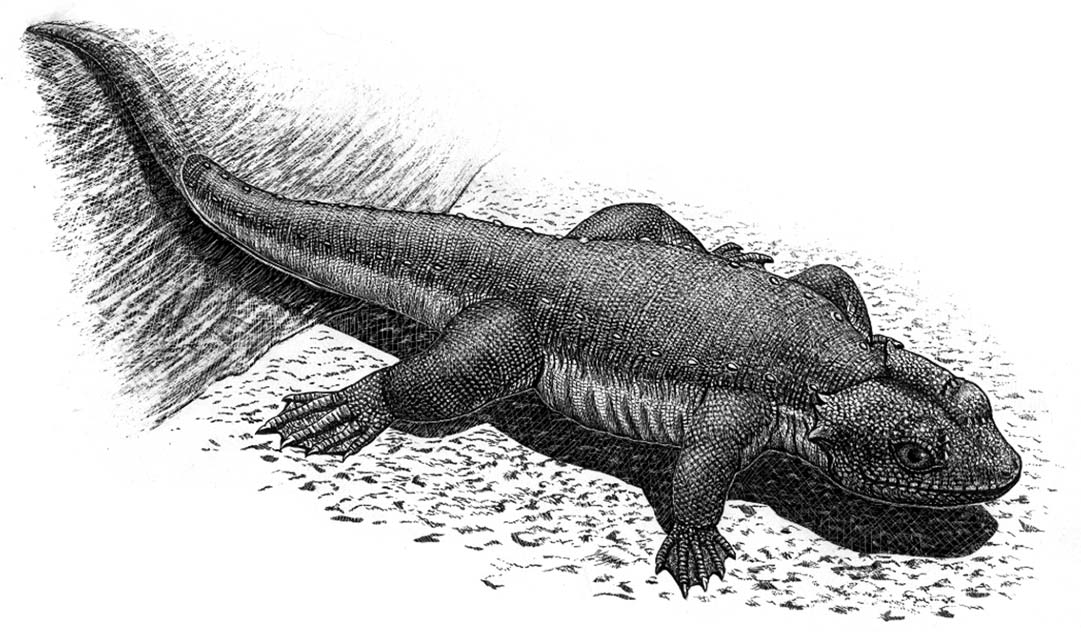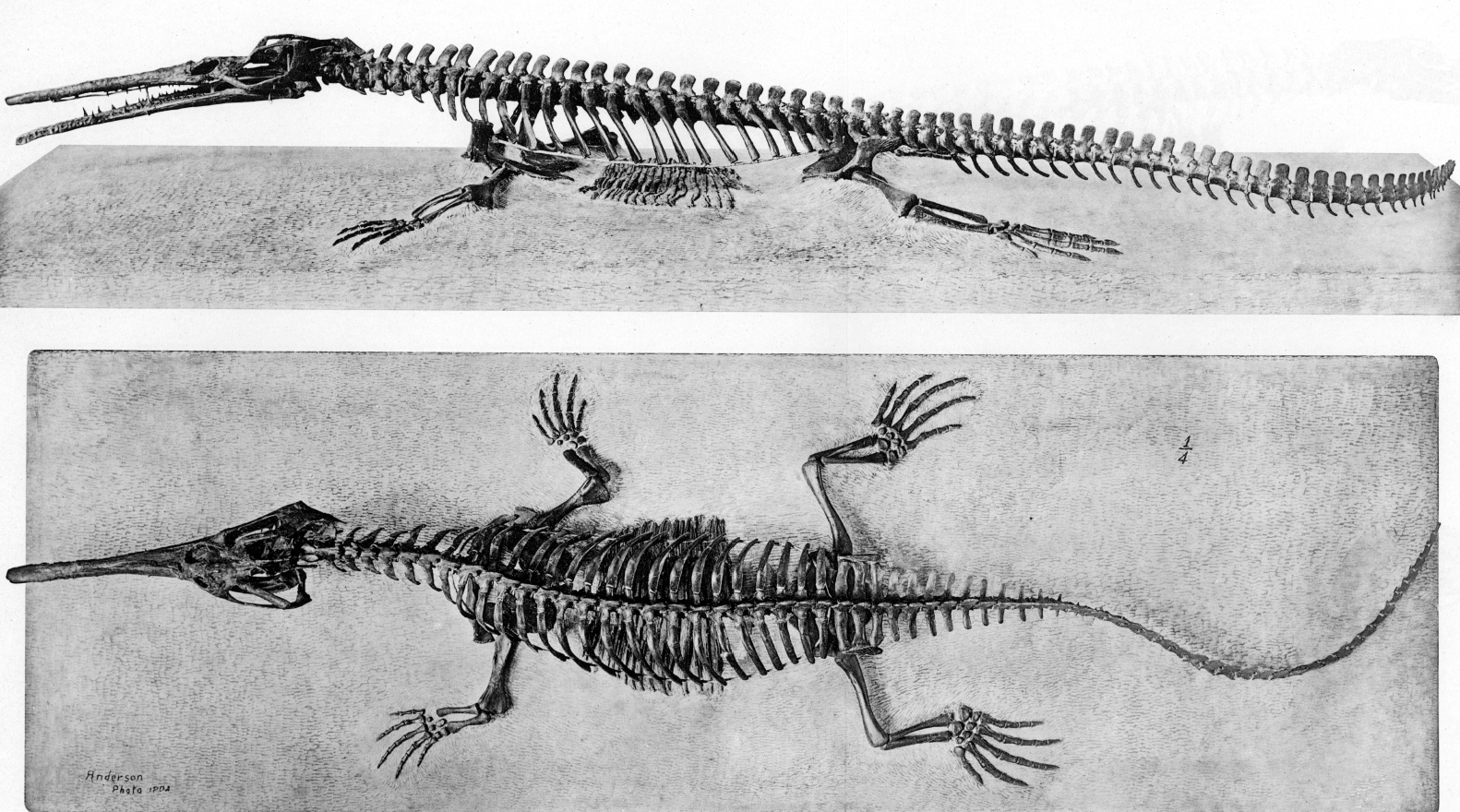|
Choristodere
Choristodera (from the Greek χωριστός ''chōristos'' + δέρη ''dérē'', 'separated neck') is an extinct order of semiaquatic diapsid reptiles that ranged from the Middle Jurassic, or possibly Triassic, to the late Miocene (168 to 11.6 million years ago). Choristoderes are morphologically diverse, with the best known members being the crocodile-like neochoristoderes such as ''Champsosaurus''. Other choristoderans had lizard-like or long necked morphologies. Choristoderes appear to have been confined to the Northern Hemisphere, having been found in North America, Asia, and Europe, and possibly also North Africa. Choristoderes are generally thought to be derived neodiapsids that are close relatives or members of Sauria. History of Discovery Choristodera was erected in 1876, originally as a suborder of Rhynchocephalia by Edward Drinker Cope to contain ''Champsosaurus,'' which was described from Late Cretaceous strata of Montana by Cope in the same paper. A ye ... [...More Info...] [...Related Items...] OR: [Wikipedia] [Google] [Baidu] |
Neochoristodera
Neochoristodera is a lineage of specialised crocodile-like fully aquatic choristodere reptiles. Noted for their long jaws and large size, these animals were predominant across the Northern Hemisphere, occurring in freshwater and coastal environments across the Cretaceous and early Cenozoic. Systematics Neochoristoderes form a monophyletic group, however there is no consensus about the relationships of the genera, which have been recovered as a polytomy in recent studies. Neochoristodera contains the named genera ''Champsosaurus'', '' Ikechosaurus'', '' Kosmodraco'', '' Liaoxisaurus'', '' Mengshanosaurus'', '' Simoedosaurus'' and ''Tchoiria''. Various taxa of uncertain affinities within this group are known, including a partial femur of a choristodere, possibly of a neochoristodere from the Cedar Mountain Formation of the United States and an indeterminate partial skeleton from the Kuwajima Formation of Japan. Evolution Neochoristoderes first appear in the Early Cretaceous of Asi ... [...More Info...] [...Related Items...] OR: [Wikipedia] [Google] [Baidu] |
Lazarussuchus
''Lazarussuchus'' (meaning " Lazarus's crocodile") is an extinct genus of amphibious reptile, known from the Cenozoic of Europe. It is the youngest known member of Choristodera, an extinct order of aquatic reptiles that first appeared in the Middle Jurassic. Fossils have been found in Late Paleocene, Late Oligocene, Early Miocene and Late Miocene deposits (~56-11.6 million years ago) in France, Germany, and the Czech Republic. Two species have been named: the type species ''L. inexpectatus'' ("unexpected") (Hecht, 1992) from the late Oligocene of France. and ''L. dvoraki'' from the early Miocene of the Czech Republic. It was not a large animal; the skull of ''L. inexpectatus'' was only about 4.53 centimeters long (1.78 in), with the total preserved body and tail length being just over 30 centimetres. A complete specimen of ''Lazarussuchus'' with preserved soft tissue was found from the Late Paleocene of France, but has not been assigned to a species. Discovery The fir ... [...More Info...] [...Related Items...] OR: [Wikipedia] [Google] [Baidu] |
Coeruleodraco
''Coeruleodraco'' is an extinct genus of choristoderan known from the Late Jurassic ( Oxfordian) Tiaojishan Formation in China. ''Coeruleodraco'' is significant as the most complete Jurassic choristodere taxon, as the only other named Jurassic choristodere '' Cteniogenys'' is based on fragmentary remains. Although similar to '' Philydrosaurus'' in its proportions and postcranial characters, it is distinct in retaining several apparently plesiomorphic characters, including a short snout, paired external nares and an open lower temporal fenestra. Description The skeleton was small, about 20.3 cm (8.0 inches) in length, not including the tail. The tail is incomplete, but including its estimated length, the total length of the skeleton would have been closer to 40.0 cm (15.7 inches). ''Coeruleodraco'' had a generalized, lizard-like body type. This is similar to some early choristoderes (like '' Cteniogenys'', '' Philydrosaurus'', and ''Monjurosuchus''), but contrasts with other c ... [...More Info...] [...Related Items...] OR: [Wikipedia] [Google] [Baidu] |
Monjurosuchus
''Monjurosuchus'' is a genus of choristoderan reptile that lived in what is now China and Japan during the Early Cretaceous. It has large eyes, a rounded skull, robust legs with short claws, and a long, thin tail. Fossils have been found that preserve soft tissue, showing that it had soft skin and webbed feet. Description and history ''Monjurosuchus'' was first found in China as part of the Early Cretaceous Jehol Biota. Named in 1940, the type species ''M. splendens'' was the first reptile described from the Yixian Formation. The holotype specimen was lost during World War II but was replaced in 2000 by a recently discovered neotype preserving soft tissue. In 2007, remains were described from the Okurodani Formation of the Tetori Group of Japan. The Japanese material represents a different species of ''Monjurosuchus'' that has not yet been named. ''Monjurosuchus'' was a small choristodere, reaching a length of 40 cm with a 5 cm skull. Unlike related choristoderes, ... [...More Info...] [...Related Items...] OR: [Wikipedia] [Google] [Baidu] |
Khurendukhosaurus
''Khurendukhosaurus'' is a genus of choristodere, a type of amphibious reptile. It is known from Lower Cretaceous rocks of Mongolia and Russia. Two species have been named. The type species, ''K. orlovi'', was named in 1984 by Sigogneau–Russell and Efimov for the fragmentary postcranial skeleton PIN 3386/3. This specimen was discovered in the Albian-age Lower Cretaceous Khuren Dukh Formation Formation at Hüren Dukh, central Mongolia. The lake deposits at this site also contain fossils of the choristoderes '' Irenosaurus'' and ''Tchoiria''. Other postcranial bones of ''K. orlovi'' have been found at this site as well. Second species ''K. bajkalensis'' was named by Efimov in 1996 for PIN 2234/201, consisting of a scapulocoracoid and a rib. These bones were found in the Lower Cretaceous Murtoi Formation at Lake Gusinoye, Buryatia, Russia. The first Russian choristodere, Efimov and Storrs (2000) found it difficult to distinguish from ''K. orlovi'' based on the ... [...More Info...] [...Related Items...] OR: [Wikipedia] [Google] [Baidu] |
Champsosaurus
''Champsosaurus'' is an extinct genus of crocodile-like choristodere reptile, known from the Late Cretaceous and early Paleogene periods of North America and Europe (Campanian-Paleocene). The name ''Champsosaurus'' is thought to come from , () said in an Ancient Greek source to be an Egyptian word for "crocodiles", and , () Greek for "lizard". The morphology of ''Champsosaurus'' resembles that of gharials, with a long, elongated snout. It was native to freshwater environments where it likely preyed on fish, similar to living gharials. History of research ''Champsosaurus'' was the first member of the Choristodera to be described. ''Champsosaurus'' was named by Edward Drinker Cope in 1876, from isolated vertebrae found in Late Cretaceous strata of the Judith River Formation on the banks of the Judith River in Fergus County, Montana. Cope designated ''C. annectens'' as the type species rather than the first named ''C. profundus'' due to the larger number of vertebrae he attri ... [...More Info...] [...Related Items...] OR: [Wikipedia] [Google] [Baidu] |
Heishanosaurus
''Heishanosaurus'' is an extinct genus of choristodere reptile from the Early Cretaceous of China. The type and currently only known species is ''Heishanosaurus pygmaeus''. It is unusual as it is much more primitive than other known choristoderes from the Early Cretaceous of Asia, and retains many plesiomorphic characters. Discovery The type specimens are represented by the blocks IVPP V25322, 25323 and 25324, were discovered in September 2003 at the Badaohao locality, in Heishan County, Liaoning Province, China, in sediments belonging to the Shahai Formation. The Shahai Formation is generally thought to overlie the Jiufotang Formation and has an uncertain Aptian-Albian age, based on the radiometric dating of the Jiufotang Formation. The remains are disarticulated inside the blocks, and were scanned using microcomputed tomography. Description Remains include disarticulated skull bones, along with limited postcranial remains. Based on the size of the skull, the animal li ... [...More Info...] [...Related Items...] OR: [Wikipedia] [Google] [Baidu] |
Philydrosaurus
''Philydrosaurus'' is an extinct genus of choristoderan which existed in China during the Early Cretaceous. The type species ''P. proseilus'' was named in 2005. ''Philydrosaurus'' was found from the Jiufotang Formation and is slightly younger than ''Monjurosuchus'', which was found from the Yixian Formation. Description Distinct ridges cover the prefrontal and postfrontal bones of the skull, distinguishing ''Philydrosaurus'' from related genera. The lower temporal fenestra, usually present as a hole in the back of the skull of choristoderes, is closed by bone in ''Philydrosaurus''. The eye sockets are large and spaced close together, similar to ''Monjurosuchus'' and '' Lazarussuchus''. ''Philydrosaurus'' is considered more basal than these choristoderes because its eyes are not as closely spaced and face laterally rather than dorsally. The skull is similar in shape to that of ''Cteniogenys ''Cteniogenys'' is a genus of choristodere, a morphologically diverse group of aqua ... [...More Info...] [...Related Items...] OR: [Wikipedia] [Google] [Baidu] |
Simoedosaurus
''Simoedosaurus'' is an extinct reptile known from the Paleocene of North America, Europe and western Asia, and a member of the Choristodera, a group of aquatic reptiles that lived in the Northern Hemisphere from the Jurassic to the early Cenozoic. Described other species, ''S. dakotensis'' later got its own genus, ''Kosmodraco''. Taxonomy French paleontologist Paul Gervais described ''Simoedosaurus'' in 1877. Though similar to and contemporaneous, ''Simoedosaurus'' is not closely related to the North American ''Champsosaurus'', instead it appears to be most closely related to ''Tchoiria'' and '' Ikechosaurus'' from the Early Cretaceous of Asia. It therefore may represent a species that immigrated into North America from Asia in the wake of the Cretaceous-Tertiary mass extinction event, though the absence of choristoderes in the Late Cretaceous of Asia makes this merely a paleogeographical speculation. Biology ''Simoedosaurus'' was an aquatic predator, specialised to a full ... [...More Info...] [...Related Items...] OR: [Wikipedia] [Google] [Baidu] |
Cteniogenys
''Cteniogenys'' is a genus of choristodere, a morphologically diverse group of aquatic reptiles. It is part of the monotypic family Cteniogenidae. The type and only named species, ''C. antiquus'', was named in 1928 by Charles W. Gilmore. The holotype, VP.001088, was collected in the Morrison Formation (Como Bluff), Wyoming in 1881 by William H. Reed. More specimens have been discovered since then, including specimens from the Late Jurassic of Portugal and Middle Jurassic of Britain, which have not been assigned to species. Description ''Cteniogenys'' was long, and probably weighed less than . The skull of this genus was long and slender, and the jaws had numerous conical teeth. ''Cteniogenys'' in the Morrison probably fed on insects and small fish. It is mostly known from freshwater sites (rivers and ponds), and is a rare find in the formation (only 60 specimens out of over 2,800 total vertebrate specimens known from the formation), mostly known from northern outcr ... [...More Info...] [...Related Items...] OR: [Wikipedia] [Google] [Baidu] |
Kosmodraco
''Kosmodraco'' is a genus of large bodied choristodere from the Paleocene of North America. Originally described as a species of '' Simoedosaurus'', it was found to represent a distinct genus in 2022. Multiple fossil skulls show a relatively short and robust snout and a skull that is considerably wider behind the eyes. Two species are currently recognized, ''K. dakotensis'' and ''K. magnicornis''. History and naming The first specimen now known to belong to ''Kosmodraco'' was discovered in 1964 and 1968 in the Polecat Bench Formation (Wyoming). These two skulls, alongside others from Montana's Bear Creek, were reported on briefly by Sigogneau-Russell and Donald in 1978, who regarded them as evidence for the presence of the Eurasian genus '' Simoedosaurus'' in North America. However, at the time, these four specimens, although thought to be diagonstic at a genus level, were still unprepared and not assigned to a species. They were subsequently stored in the collection of the Prin ... [...More Info...] [...Related Items...] OR: [Wikipedia] [Google] [Baidu] |
Irenosaurus
''Irenosaurus'' is a genus of choristodere, a type of amphibious reptile. It is known from a single fragmentary postcranial skeleton (PIN 3386/2), discovered in the Aptian-age Lower Cretaceous Hühteeg Formation at Hüren Dukh, central Mongolia. The type species is ''I. egloni'', which was originally described as a new species of the related choristodere ''Tchoiria'' in 1983 by Efimov. Efimov transferred the species to the new genus ''Irenosaurus'' in 1988. Evans and Hecht (1993) questioned the separation of the taxon from ''Tchoiria namsarai'' from the same locality on the grounds that the differences between the two may not have been greater than those of various species of the choristodere ''Champsosaurus''. A later review by Efimov and Storrs (2000) retained the two as separate, noting that some characteristics of ''Irenosaurus'' are more like ''Khurendukhosaurus ''Khurendukhosaurus'' is a genus of choristodere, a type of amphibious reptile. It is known from Lowe ... [...More Info...] [...Related Items...] OR: [Wikipedia] [Google] [Baidu] |




